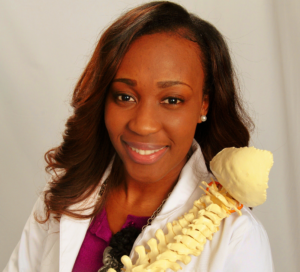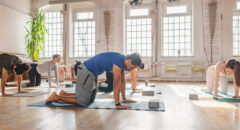
Summer break is officially over and it’s time for our kids to enter the school hallways for another year of learning and fun. You’ve stocked up on all the items on the school supply list, but have you thought of ways to preserve your child’s posture? Implementing good posture habits with these simple tips will position your kids for a pain-free school year.
Why Is Posture Important?
When you were a kid, you probably remember hearing your teachers or your parents saying to you, “Sit up straight!” or “Don’t slouch!” Like most kids, you probably didn’t think it was all that important. Turns out that the adults were right! Good posture helps to stand, walk, sit, lie without putting unnecessary wear and tear on our muscles, joints, and internal organs. This helps to prevent sports injuries, joint and muscle pain, and early onset degenerative joint disease.
Smart Device Posture
Our kids won’t be putting away the smartphones and tablets just because summer break is over. However, too much time on smart devices can cause an imbalance in the muscles of the spine and upper body. This can lead to “text neck”, a straightening of the normal curve in the neck. Text neck alters the normal posture of your child. It can lead to difficulty or discomfort with simple school tasks like reading the words on a whiteboard or carrying a backpack. Bad smart device posture can cause chronic pain, decreased neck motion, and achy muscles.
RELATED: Pay Attention To Your Posture! The Pay Off Will Be Priceless
Good Posture Points For Smart Devices:
1. Change The Position
Most of us look at our smart devices with our heads down and our chins tucked to our chests. Your child probably does the same thing. Instead of your child holding the device in his or her lap or on a desk, he or she can hold or place the device at eye level when reading long posts or articles. This will allow them to maintain good posture while using their smart devices.
2. Take A Stretch Break
Your child should take a break to look up and stretch after using a smart device for 30 minutes. Looking down for prolonged periods of time leads to a straightening of the cervical curve and can cause pain. Taking a break to stretch the muscles of the neck and upper back will help to combat text neck and preserve posture.
Backpack Posture
Choosing a backpack for school is more than just getting one with cool characters and colors. Your child wearing a backpack that is poorly fitted, oversized or that is worn improperly will lead to bad posture. This can be a source of neck pain, back pain, and chronic spinal conditions.
Good Posture Points For Backpacks
1. One Size Does Not Fit All
Backpacks come in different sizes and you need to find a good fit for your child. The top of your child’s backpack should start at the base of the neck and the bottom of the backpack should be just above the buttocks. If you are ordering a backpack online, find the dimensions of the backpack and measure your child to ensure that you are purchasing the correct size. If you purchase one from a brick and mortar store, try it on your child before heading to the checkout line.
2. How To Lift
When your child lifts their heavy backpack with one hand and throws it over their shoulder in one swing, it leads to bad posture. This type of improper lifting can cause injury to the muscles and joints of their shoulders and spine.
To properly lift a backpack:
- Stand in front of the backpack facing the side with the straps.
- Bend both knees to lower your body towards the backpack.
- Place one hand on each strap of the backpack.
- Begin to lift the backpack and straighten your legs as you return to a standing position.
- Begin to put the backpack on, one strap at a time.
3. How To Wear
Wearing a backpack on one shoulder is a trend that’s been around for decades. However, if your child is carrying a backpack this way, it can cause functional scoliosis, shoulder pain, and back pain.
Your child should wear both straps to ensure the weight of the backpack is evenly distributed. The weight of the backpack should not exceed 10% of your child’s weight. If your child carries heavy textbooks, a backpack with a chest strap will help prevent discomfort and injury.
Desk Posture
Your child spends a great deal of time sitting at a desk at school. Prolonged sitting can cause pelvic and low back misalignments which can lead to pain. There is no way to avoid sitting in a school desk, but your child can apply a good sitting posture throughout this school year.
RELATED: 8 Ways Long-Term Sitting Is Affecting Your Body
Good Posture Points For School Desks
1. Slouching Should Be Avoided.
Your child should sit with his or her feet flat on the floor and back against the back of the chair.
2. Set Up The Desk Properly
Your child’s desk should be in a position that doesn’t require the rotation of the head or body to see assignments on the whiteboard or the teacher during instruction.
3. Don't Sit For Too Long!
If your child changes classes throughout the day, this is a good time for your child to stretch the upper and lower back before the next class begins.
RELATED: Power Of Posture: Change How You Sit & Stand For Success
Teachers can implement stretch breaks throughout the day to help reinforce good posture habits.
 Dr. Candace McMillon-Dantley is the health-empowering creator of The Doc Knows and she’s on a mission to motivate you to a life of health. She has a Doctorate in Chiropractic Medicine and a Bachelor of Science in Biomedical Sciences. When she’s not health writing, she is health motivating and educating during her interactive presentations on healthy nutrition, self-care and conditions of the body. Her experiences as a business owner, chiropractor, wife and mom of two resonate and relate with her audiences. Connect with Dr. Candace on Instagram @drcandace.
Dr. Candace McMillon-Dantley is the health-empowering creator of The Doc Knows and she’s on a mission to motivate you to a life of health. She has a Doctorate in Chiropractic Medicine and a Bachelor of Science in Biomedical Sciences. When she’s not health writing, she is health motivating and educating during her interactive presentations on healthy nutrition, self-care and conditions of the body. Her experiences as a business owner, chiropractor, wife and mom of two resonate and relate with her audiences. Connect with Dr. Candace on Instagram @drcandace.









